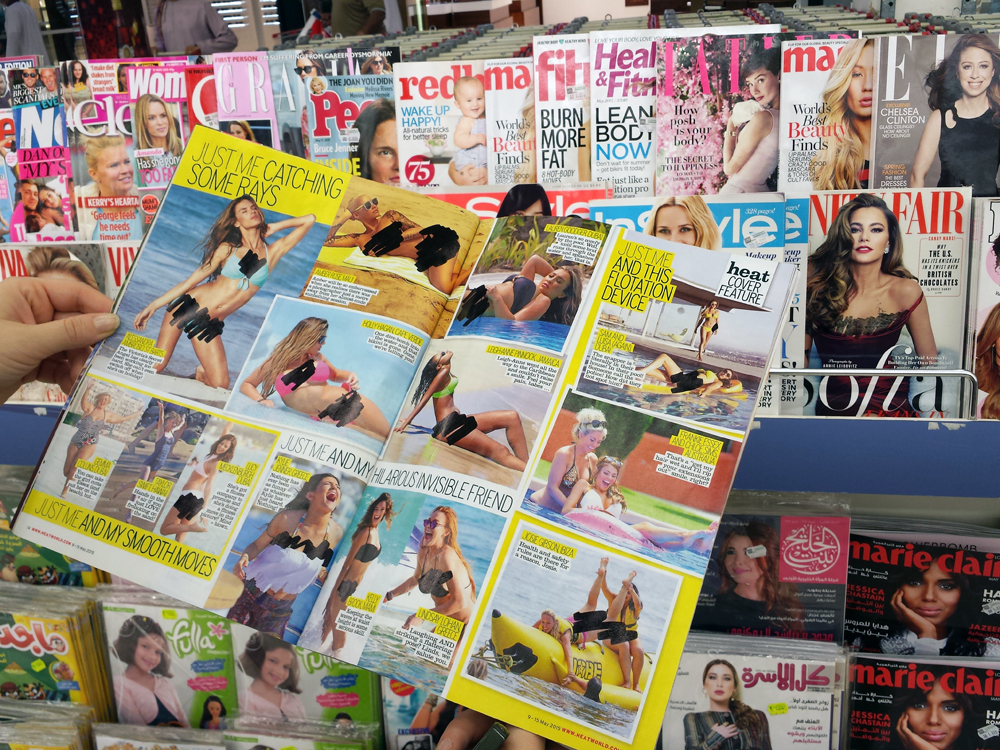I was in Oman last month, where I was invited to teach government representatives and agencies about e-accessibility. It was a remarkable week; in the evenings after teaching I was able to wander around the amazing world that is Muscat, Oman’s capital city. Oman is a truly unique country containing a mix of ancient cultures. A country whose society has been so rapidly and radically transformed under its beloved and benevolent monarch, Sultan Qaboos bin Said. One has to consider that in 1970 Oman was a country with only one elementary school, and now is modern and thriving and is, arguably, the most un-radicalized part of the Arabian Gulf.
One thing that stood out to me during my trip was the magazine stand at the checkout of a Carrefour store (which reminded me of my local Loblaws or Safeway). The plethora of magazines was remarkable, but not for the reasons you may think:
Someone had taken a big Sharpie and meticulously hand-modified every image on every page of every copy in order to cover up parts of women’s bodies. Of course, as pointed out by Dr. Aisha Sherazi, an Ottawa writer and pastoral care worker I corresponded with while writing this piece, there are different interpretations of Islam’s teachings and so the religion is practised in widely different ways. Most Omanis are Ibadis (which perhaps helps it deal with its Sunni and Shiite neighbours)–but regardless of what influenced this particular instance of modesty toward nudity, whether religious belief or something else altogether, it’s safe to say that somewhere along the chain of distribution these images were deemed to be showing more of a woman’s body than was thought appropriate for Omani culture.
These magazines are remarkable artifacts of what happens as we become one global civilization, and are an understandable reaction to market forces that create a demand for trashy magazines, combined with a localized need to conform to local standards. I imagine the magazine distributor hires extremely low-paid foreign workers to modify the magazines before they go on the shelves.
This brings up a number of things worth thinking about. Can one really sell a $5 magazine at a profit if they need to be modified by hand? Wouldn’t it be interesting to read the rules as to what must get covered and what can be left alone? Why just the women? Is it the intention of the principle behind this activity that the person wielding the Sharpie is forced to examine these images intensely in order to spare someone else having to see them? What is the role of we Sharpie-wielding designers in the West in creating a situation where so many resources (both natural and human) are being wasted in order to share questionable content more broadly?
And what of such selective censorship? What of the moral rights of the art director, whose painstaking (though perhaps crass) layouts are being mechanically desecrated with this most unexpected tagging?
Maybe such Talmudic cleverness distracts us from the larger question: how do we create a civilization where the best of our cultures can not just coexist but nurture a better civilization… whereas this is perhaps an example of the opposite… a race to the bottom, wasting both paper and Sharpies? Both dignity and focus?
And for the accessible PDF equivalent of such a magazine, what would be the alternative text for a markered-out censored photo in a fashion magazine?
So I’m tempted to say that I’m not for it or against it, just conveniently naive and looking for opinions. Not as a Muslim nor a woman, but I do love a good Sharpie…
Is this just a wacky artifact of cultural crossover? I think not. Rather, ultimately, anything that obscures the core issue is a concern: that busying ourselves covering up these naughty bits while continuing to propagate a culture that, in the pursuit of consumerism, sacrifices our young women who, no matter where they live, are taught their bodies are not okay if they are not thin enough, not white enough, not tall enough.
What do you think?
Reviewed August 30, 2015
